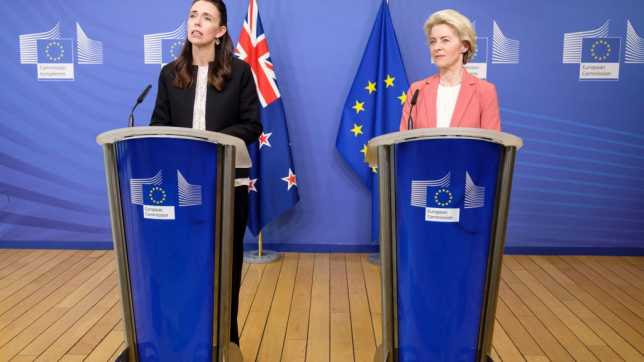The dairy industry is rubbishing the Government’s claims that New Zealand’s major pastoral industries stand to gain $600 million a year in new export receipts once a new trade deal with the European Union is fully implemented.
The dairy and meat sectors unleashed on the Government within minutes of Prime Minister Jacinda Ardern agreeing a trade agreement with the EU in Brussels overnight.
Once implemented the deal scraps tariffs on a range of second-tier exports such as honey and kiwifruit but does little to shift the dial on market access for the two largest primary exporters.
Meat Industry Association chief executive Sirma Karapeeva said the creation over seven years of 10,000 tonnes of new beef quota was a drop in the bucket compared to the EU’s overall annual consumption of 6.5m tonnes.
“This outcome maintains small quotas that will continue to constrain our companies’ ability to export to the EU.
“This agreement is not consistent with our expectations and the promise for an ambitious, high-quality trade deal,” Karapeeva said in a statement.
Dairy Companies Association chairman Malcolm Bailey said the increases in quotas for butter and cheese represented just 0.14% of EU consumption and were no better than the EU offer former Trade Minister David Parker had labelled “insulting” two years ago.
Speaking from Brussels Bailey told Farmers Weekly the assumptions the Government had used in calculating the $600m in annual gains from the deal for meat and dairy were flawed and would only be a fraction of that sum.
“The way they have calculated the benefit for dairy is really just not accurate because it assumes zero value on all those tonnes of product that we are currently selling somewhere else.
“It is only the marginal uplift in price that we could possibly gain from diverting it to this market that can be counted as an FTA benefit and that is a small fraction of $120m a year rising to $600m a year that they are calculating.”
Bailey said the in-quota tariffs that remained meant that even the small quotas the EU had granted would be of limited use to NZ dairy exporters.
“We don’t actually see a consistent trading opportunity where an in-quota tariff remains because the world price and the internal EU price have a fair degree of convergence so why would you drop value by sending the product to the EU paying a tariff?”
Bailey said the Government’s estimated gains also did not appear to account for the cost to the industry of handing over the exclusive use of several cheese names to EU producers.
Under the agreement NZ producers of feta, along with port and sherry, would have to cease using those names within five to nine years.
Existing producers of parmesan and gruyere will be able to continue to use those names but new producers of the cheeses will not.
“We have not tried to cost that but it is clearly a negative,” Bailey said.
Bailey said there were still details yet to emerge which could also detract from the minimal benefits already announced.
“There is still some fine detail around quota administration that is being worked out that best we can tell will be quite onerous and commercially unattractive.”
While acknowledging the gains for other exporters from the deal with the EU Bailey said the key pastoral industries had argued such was the relative sizes of their contributions to the NZ economy that Ardern would have been to better calling off the talks and asking negotiators to resume at a later time.
When asked what the response had been from Ardern and Trade Minister Damien O’Connor to those pleas Bailey said there had been none.
“We have had no response from them. They simply did not respond to that request.”
Bailey said statements in recent days from Ardern and other ministers that the Government was prepared to walk away from a deal if it didn’t deliver for key exports could be construed as disingenuous.
“This is where the Government’s calculated benefits could be argued and if you do not know any better then that does sound commercially meaningful.
“It certainly isn’t when you actually understand the full picture.”
Key outcomes:
– 99.9% of horticultural trade to enter EU tariff-free on entry-into-force, with tariff savings of $46m annually;
– 99.5% of fish and seafood exports to enter tariff-free on entry-into-force; tariff savings of $19.6m within 7 years as tariffs fully removed;
– Tariffs on 97% of wine, honey and products like seeds to be removed on entry-into-force. Annual tariff savings of $3.5m for Manuka honey;
– New beef quota of 3,333 tonnes created on entry-into-force, rising to 10,000 tonnes after seven years. New sheep meat quota of 5,429 tonnes, rising to 38,000 tonnes after 7 years. Existing tariff-free quota of 125,000 tonnes remains, but fails to restore NZ’s pre-Brexit EU quota of 228,000 tonnes.
– New butter quota of 36,000 tonnes, created by lowering the in-quota tariff on existing butter quota and creating 15,000 tonnes of new quota over seven years. Export revenue if butter quota is filled estimated by MFAT to be $258m annually.
– New and improvements on existing cheese quota equal to 31,000 tonnes. New exports, if filled, estimated at $187m annually.
– New quota for milk powders, rising from 5,000 tonnes to 15,000 tonnes over seven years. The in-quota tariff will be 20% of the tariff on the existing smaller quota.
Source: MFAT










